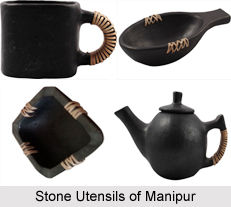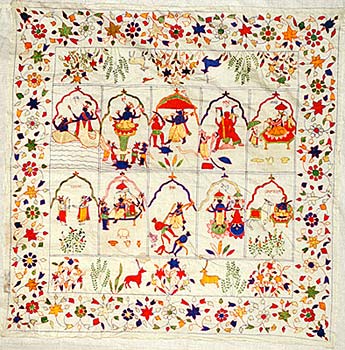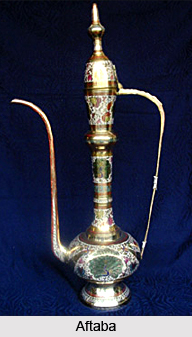 Gold Jewellery craft in India is deeply embedded in the nation`s history and has been influenced by foreign cultures. The rich heritage and culture of India prompts the Indian inhabitants to decorate themselves with the rich variety of ornaments made from various metals especially from gold. India is considered as the only country where the jewellery plays a significant role in the adornment of personal embellishments. The people of India, led by spiritual and superstitious beliefs, believed that the ornaments would help them to keep away from evil forces. Gold jewellery art in India, since the remote past therefore played a major role.
Gold Jewellery craft in India is deeply embedded in the nation`s history and has been influenced by foreign cultures. The rich heritage and culture of India prompts the Indian inhabitants to decorate themselves with the rich variety of ornaments made from various metals especially from gold. India is considered as the only country where the jewellery plays a significant role in the adornment of personal embellishments. The people of India, led by spiritual and superstitious beliefs, believed that the ornaments would help them to keep away from evil forces. Gold jewellery art in India, since the remote past therefore played a major role.
At about 4000 years ago gold was first used as a metal. Archaeologists suggest that the use of gold began in the Middle East where the first known civilizations began. The oldest pieces of gold jewellery, Egyptian jewellery, were found in the tomb of Queen Zer and of Queen Pu-abi of Ur in Sumeria and are the oldest examples found of any kind of jewellery in a find from the third millennium BC.
Over the centuries, most of the Egyptian tombs were raided, but the tomb of Tutankhamen, the young Pharaoh was discovered undisturbed by modern archaeologists. Inside the grave, the largest collection of gold and jewellery in the world was found and included a gold coffin whose quality showed the advanced state of Egyptian craftsmanship and gold working that is in the second millennium BC. At the early age, jewellery of stones, pebbles, and some other natural objects were used but after the initiation of the metals in India, the trend of wearing gold ornaments had been developed due to the glint and the durability of the metal. This further paved the way to the introduction of gold jewellery art in India whilst popularizing it to the core.
Gold Jewellery Craft in Ancient India
It is evident from various archaeological excavations that gold jewellery craft in India was prominent even in the ancient days. It had been discovered that in the earliest days the people, especially women, would use little clothing but they would bedeck themselves with ornaments. A naked dancing girl, alluring and bedecked with ornaments and bangles on one arm stretching from the wrist almost to her shoulder had been found in the Harappa excavation. Almost a similar art of sculpture of minimum attire and a profusion of ornaments was found through the excavation of Gandhara and Gupta Empire. All these indicate the presence of gold art in India even in the days of ancient times.
Gold Jewellery Craft in India during Mughal Era
During the later years, the Mughal emperors encouraged the gold jewellery craft in India. The Mughal jewelleries represented an incredible high standard and quality. Mughal Empire had amalgamated the Hindu and Muslim trends and made a fusion in the styles of gold jewellery craft in India. The Mughal emperors, by establishing Karkhanas or workshops and employing artisans from different sects of excellence encouraged this amazing art in India. The enamelling in gold jewelleries was also introduced by the Mughals.
Enamelling as a gold jewellery art has been well adored and is still practiced in various parts of India like Nathdwara, Jaipur, Varanasi and Kolkata. Enamelling is categorised into various types, as in India, it is recognized as Champleve. An alternative of enamel is known as Thewa, which is found in Pratapgarh district, Rajasthan in a small amount. After the termination of the Mughal Dynasty the artisans moved to other places and the gold jewellery art of the Mughal period was merged with the crafts of the other places.
 Gold Jewellery Craft in India during 19th Century
Gold Jewellery Craft in India during 19th Century
The gold jewellery art which was prevailing gained a rich contour with the western influence in Indian art and craft. The setting of gems in gold ornaments is an example of this western influence which became a famous gold jewellery art in 19th century India. Although India maintained the tradition of the jewelleries that are engraved with gem stones and semi precious gems from the early history of the ruling emperor, yet the western influence offered a rather contemporary touch to it.
The jewellery of different regions differs from one another and each type carries a speciality of their own. The original abode of the snake chain is Kilhapur in Maharashtra. The snake chain has gained its popularity in Hyderabad in recent times. The ornaments such as Odiyaanam (gold waist belt), Jimikki (eardrop), Vanki (armlet) are commonly used in all parts of South India. Some of the popular gold ornaments used in various parts of India are Paambadam which are a great lump of gold and are in all one piece represent six earrings, worn by the rural Tamil women. The earrings for Tamil men are known as Kadukkan. Kammal, Jimikki, Lolakku are some forms of earrings for women in Tamil Nadu. In western and Southern India Mangalsutra, a gold pendant hanging from a necklace of black gun-metal and gold beads, is considered to be a symbol of the marital status of a woman and is considered as an auspicious sign of marriage.
Gold in Modern India
People of India are too much conscious about the use of gold. Now in modern times, Indian government marked the genuine gold as the trade mark where the consumer will not be cheated. Ten years ago, people use gold ornaments occasionally, but now the demand of acquiring light gold ornaments by the ladies for the daily use become very popular. Wedding gold ornament demand accounts for a substantial proportion of overall jewellery demand. This is particularly true in the south of India, where the most popular wedding jewellery sets tend to be the more traditional, intricate but bulky styles in heavier weights. In the northern cities there has been a trend towards more `western` styles, and lighter wedding sets, as well as diamond set pieces, are becoming increasingly popular in Indian market. Indian consumers also regard gold jewellery as an asset and are well aware of gold`s profit as collection of value.
Gold Jewellery Craft has evolved through the decades and still holds lot of significance in the Indian culture. It has attained a whole new level in India and is well admired for its dazzling as well as elegant look.



















